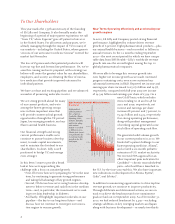Eli Lilly 2010 Annual Report Download - page 8
Download and view the complete annual report
Please find page 8 of the 2010 Eli Lilly annual report below. You can navigate through the pages in the report by either clicking on the pages listed below, or by using the keyword search tool below to find specific information within the annual report.
6
nonsquamous non-small cell lung cancer; however,
necitumumab continues to be studied in a separate Phase
III trial for a different type of lung cancer.
In our emerging autoimmune portfolio, we began Phase
III trials of our BAFF antibody for both rheumatoid
arthritis and lupus, and our IL-17 antibody in rheumatoid
arthritis could potentially enter Phase III this year. In
addition, along with our partner, Incyte Pharmaceuticals,
we disclosed promising Phase IIa data in rheumatoid
arthritis for our oral JAK-1/JAK-2 inhibitor.
In 2011, we’ll complete the Phase III DURATION-6 trial
comparing Bydureon™ to liraglutide. We also expect to
present initial results from the Phase III trial in advanced
nonsquamous non-small cell lung cancer of Alimta induc-
tion therapy followed by Alimta maintenance therapy.
We completed enrollment in late 2010 for both Phase III
trials of solanezumab, our antibody being studied for the
treatment of Alzheimer’s disease. The treatment duration
in each trial is 18 months, so we will complete each study
18 months after the last patient was enrolled.
During the year, we experienced pipeline disappoint-
ments, including three potential medicines in Phase III
trials. These setbacks underscore the risks of pharmaceuti-
cal innovation, but also the need to find solutions to what
has become an industrywide productivity problem.
That’s why Lilly is determined to adapt our innovation
engine to meet the ever more exacting challenges of phar-
maceutical research. We’re working to build an in-depth
understanding of patients’ needs into the earliest stages of
research. We’re assessing the potential of new molecules
in terms of what’s truly valued by patients, physicians,
and payers. We’re better assessing and managing risk in
the face of ever-increasing expectations. We’re striving
to anticipate the concerns of regulators so that we can
answer their questions in our clinical testing. And we’re
focusing all our energy and creativity on speeding up the
progression of promising molecules and reducing the cost
to bring a new medicine to patients.
In past years, I’ve reported on our efforts on many fronts
to improve the speed and power of R&D at Lilly: build-
ing a network of research capabilities inside and outside
our own walls, creating a Development Center of Excel-
lence, strengthening our biotech infrastructure, applying
tailoring strategies to virtually every molecule in clinical
development, and redesigning our company to create
a clear line of sight from innovation to the customer.
We continue to pursue these goals with a great sense
of urgency, and we remain on track to have at least 10
molecules in Phase III by the end of 2011—with more
coming behind.
Looking to a promising future
To sum up, Lilly enters 2011 with a keen awareness of the
challenges of the YZ period ahead, but also with strate-
gies in the near, middle, and long term to meet those
challenges and to achieve sustained growth.
Lilly’s fundamental strategy is predicated on innovation.
We must maintain our focus on what made this company
great: the discovery and development, the manufacturing
and marketing of new medicines that help address unmet
medical needs and provide value not only for patients,
but for health care professionals and for payers, as well.
We must be as tenacious as the diseases we’re fighting.
The science has never been more promising, and the need
for new medicines never greater.
I recently visited our ImClone labs in New York City,
which opened in September 2010 (see page 3), where I
met with some of our outstanding scientists and toured
the impressive facilities. Visits like this around the com-
pany reaffirm my conviction that Lilly has the intellectual
capital, the tools, and the determination—along with the
financial strength—to meet this moment and seize the
many opportunities before us. I remain deeply apprecia-
tive of the level of commitment, the level of professional-
ism, and the combined and individual expertise that all
Lilly employees bring to this enterprise.
Our commitment to scientific excellence and a strong
focus on research have indeed propelled this company
to greatness over nearly 135 years. These same qualities
underpin our hope for future success. We are acting with
urgency, not simply to survive YZ, but to emerge with
even greater strength and the capacity to drive future
growth for the benefit of patients and shareholders.
For the Board of Directors,
John C. Lechleiter
Chairman, President, and Chief Executive Officer





















